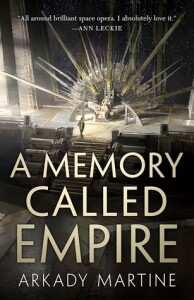 Mahit Dzmare has been chosen to represent her world as Ambassador to Teixcalaan, the galactic superpower. Her “world” is tiny Lsel, a space station housing some 30,000 souls, affiliated with no planet, which controls a small sector that’s rich in minerals the empire needs. She has within her the imago – a personality and memory recording – of the former Ambassador, Yskandr Aghavn – who seems to have disappeared. Her job is to find out what happened to Aghavn and ensure that all is well between tiny Lsel and the huge and ravenous Teixcalaan, so the empire will have no excuse to decide to subsume Lsel into its hegemony and destroy its fiercely independent culture.
Mahit Dzmare has been chosen to represent her world as Ambassador to Teixcalaan, the galactic superpower. Her “world” is tiny Lsel, a space station housing some 30,000 souls, affiliated with no planet, which controls a small sector that’s rich in minerals the empire needs. She has within her the imago – a personality and memory recording – of the former Ambassador, Yskandr Aghavn – who seems to have disappeared. Her job is to find out what happened to Aghavn and ensure that all is well between tiny Lsel and the huge and ravenous Teixcalaan, so the empire will have no excuse to decide to subsume Lsel into its hegemony and destroy its fiercely independent culture.
So far, a pretty typical space opera setup. A Memory Called Empire is the first book of a planned trilogy. It won the 2020 Hugo Award for best novel, and deservedly so, for Martine has created in Teixcalaan a unique and complex civilization peopled by memorable characters – and an equally memorable character in this book’s lead, Dzmare. The book’s themes include the trauma inflicted by colonialism, which has become something of a trope (although a necessary one) in modern space opera – but it also delves into complex ideas about language and memory and personality, with a new twist on the old chestnut of free will vs. fate. It doesn’t have as action-packed and brilliant a plot as its sequel A Desolation Called Peace, which I’ll be reviewing separately, but it is a very assured debut for Martine.
Teixcalaan seems to be loosely based on Earth’s Inca empire (or perhaps an amalgam of Mesoamerican cultures), as though in this universe the Incas were not conquered by Spain but instead maybe became one of Terra’s dominant players and led the way to the stars. That happened so long ago that nobody remembers when, or where the home planet was. Teixcalaan has been bloodthirsty and expansionist for most of its history but seems to be settling down a bit under the reign of its now ancient Emperor Six Direction. Warriors they are but not barbarians. They revere flowers and birds, and their language is highly poetic in form, such that poetry is a universal passion among its citizens. Symbolism and poetic allusion are rampant. Their names always combine a number and an inanimate object that say something about their personality or vocation or … something.
Even in distant, fiercely independent Lsel, children like Mahit grow up loving the art and poetry of The Jewel of the World as Teixcalaan is called. They take aptitude tests that match them with a profession. If they’re on a diplomatic track like Mahit, they take further tests to see which imago line they would be compatible with.
Just before the tale begins a Teixcalaanli starship docked at Lsel Station and requested a new Ambassador, hinting that Yskandr may be dead. Mahit is exceptionally compatible with Yskandr and the multi-generational line of which he is the latest, even though he’s male and she’s female. But there’s a bit of a problem. The last time Yskandr visited Lsel to have his imago updated was 15 years ago. And Teixcalaan wants her to leave now, which only gives her the voyage of several weeks to integrate with Yskandr’s imago, and even then, everything she learns from him will be 15 years out of date. And early in her adventure, something starts going wrong with her imago, so she has only intermittent contact with this rather odd personality inside her.
From the moment Mahit arrives at the fully urbanized planet Teixcalaan, which is called The City by all the civilization’s citizens, she’s plunged into crisis after crisis, most of which she has help navigating from her liaison, a young woman from the Information Ministry named Three Seagrass. Political change seems to be brewing, and in such a warlike society, can that happen peacefully? What did happen to Yskandr, and how involved was he with the realm’s internal politics? Who can Mahit trust – Three Seagrass, imperial advisor Nineteen Adze, Yskandr’s out of date imago? Emperor Six Direction? Herself?
Because Mahit – viewed as a barely human barbarian by most people in Teixcalaan – is definitely a change agent herself. Young and initially unsure of herself, prone to lapses of attention and internal rhapsodies and fugues, she’s an amazing character. Someone you think you’d like to spend time with, even though you’d be annoyed with her a lot. As you can be, reading A Memory Called Empire. Even during some moments of the plot that strained my credulity beyond my willing suspension of disbelief, I was willing to keep going. Memory is unquestionably worth it, both on its own and because it gets you to its knockout of a sequel.
(Tor, 2019)
Arkady Martine (a.k.a. Dr. AnnaLinden Weller) is a Byzantinist and urban planner among other things, which sheds some light on this series.
